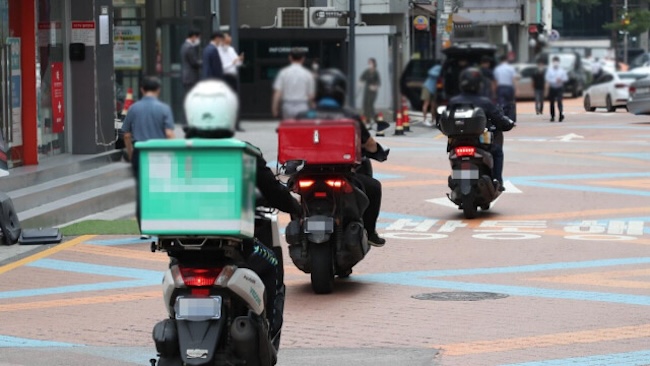
Some franchise owners and restaurants have sparked controversies by charging higher prices for delivery orders compared to dine-in meals, citing the burden of the apps’ commission fees. (Image courtesy of Yonhap)
SEOUL, May 7 (Korea Bizwire) – With the major food delivery apps in South Korea waging a “free delivery” war to lure customers, some franchise owners and restaurants have sparked controversies by charging higher prices for delivery orders compared to dine-in meals, citing the burden of the apps’ commission fees.
On May 5, industry officials said several major franchises have officially adopted the controversial “dual pricing” policy, where delivery menu prices are higher than in-store prices.
Popeyes Korea, a chicken and burger franchise that raised menu prices on April 15, announced that “delivery menu prices will be set around 5 percent higher on average compared to in-store prices.”
KFC, which hiked prices in March, also stated on its website that it operates “separate delivery prices.”
As a result, the price gap between delivery and in-store orders can reach up to 800 won for certain menu items at KFC. Burger King and McDonald’s have similar dual pricing policies in place.
Beyond major franchises, a significant portion of independent restaurant owners also charge different prices for delivery versus dine-in orders, industry officials said.
Franchise headquarters and restaurant owners argue that they have no choice but to adopt dual pricing due to the delivery apps’ percentage-based commission structures, which they say unfairly increases their burden as sales grow.
“To get the free delivery benefit, we have to subscribe to the percentage-based commission service required by the apps, where we pay a certain percentage of our sales as a fee,” said one franchise industry official, who requested anonymity to discuss business practices.
“Under this system, the more we sell, the higher the commission fees to the delivery apps.”
For example, to offer free delivery through Baemin, one of the largest apps, restaurants must subscribe to the “Baemin 1 Plus” plan, paying a 6.8 percent commission plus a 2,500 to 3,300 won delivery fee per order paid to Baemin’s delivery workers.
They must also pay up to 3 percent in payment processing fees and value-added taxes. Coupang Eats has a similar “Smart Pay” plan with a 9.8 percent commission plus a 2,900 won delivery fee and 3 percent payment fees.
For Yogiyo, restaurants pay a 12.5 percent commission along with payment processing and taxes.
“As a restaurant subscribed to all three major delivery apps, we’re left with no choice but to raise minimum order amounts or adopt dual pricing for deliveries,” said one restaurant owner, who also requested anonymity.
“It’s the greed of the platforms and the government’s indifference under the pretext of ‘self-regulation’ that’s leaving us to face customer backlash.”
The delivery apps maintain that free delivery ultimately leads to increased sales for restaurants, arguing there is no problem.
In particular, Baemin has been strengthening measures to curb dual pricing, expanding its “Same As Storefront Price” badge program to all of Seoul last month after initially launching it in November 2021.
“Our 6.8 percent commission is the lowest among major delivery apps, and restaurant owners can choose between our percentage-based ’1 Plus’ plan or a fixed-rate plan,” said a Baemin official, who requested anonymity to discuss company policies.
“While we can’t stop restaurants from dual pricing, it’s an issue of consumer trust, so we’re reinforcing the ‘Same As Storefront’ badge program.”
Ashley Song (ashley@koreabizwire.com)






